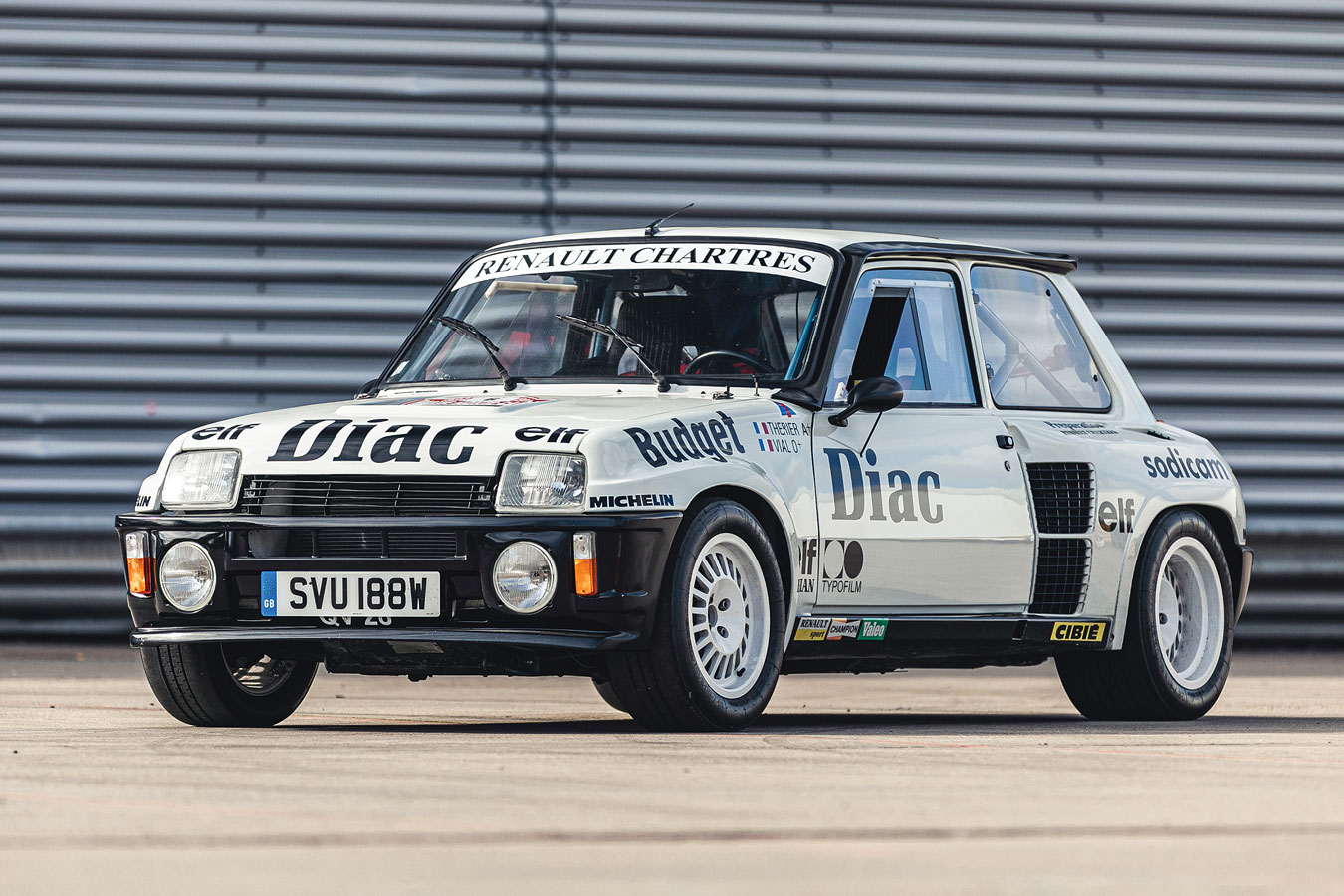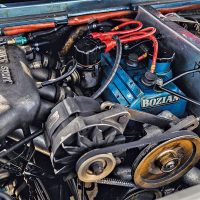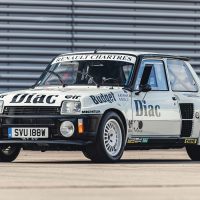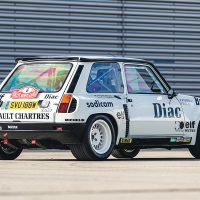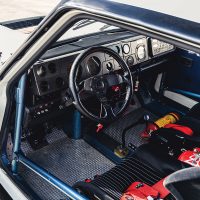SCM Analysis
Detailing
| Vehicle: | 1982 Renault 5 Turbo Group 4 |
| Years Produced: | 1980–86 |
| Number Produced: | 400 Turbo 1, 3,176 Turbo 2, 20 “semi-factory” competition cars |
| SCM Valuation: | $86,000 |
| Chassis Number Location: | Stamped on crossmember under front seats |
| Engine Number Location: | On block, intake side |
| Club Info: | Renault Turbo Owners Club |
| Website: | http://www.rtoc.org |
| Alternatives: | 1982–83 Lancia Rally 037, 1981–82 Ford Escort RS 1800, 1984 Porsche 911 SC/RS |
| Investment Grade: | B |
 This car, Lot 434, sold for $444,629, including buyer’s premium, at Silverstone Auctions’ NEC Classic online sale on November 13, 2020.
This car, Lot 434, sold for $444,629, including buyer’s premium, at Silverstone Auctions’ NEC Classic online sale on November 13, 2020.
As SCMers know, there is an almost infinite number of definitions of insanity. If you limit the horizon to motorsport, it is still a large number, but I will propose that professional World Rally Championship driving comes close to pegging the meter. Going absolutely flat-out down a twisting, rutted, gravel, snowy or paved road that you have most likely never seen before, with no guardrails and big trees a few feet past the ditches, requires insane competence or a death wish. Or both.
Rally comes of age
International rallying was a relatively genteel (and amateur) sport until the 1970s, when promoters figured out that crowds were willing to pay to watch production-based cars cheat death. Auto manufacturers quickly learned that rallying was a tremendously effective “win on Sunday, sell on Monday” marketing tool, so they threw huge budgets at it. By the 1980s, professional rallying was attracting more paying customers than Formula One, and though the cars were technically production-based, the hardware was pure race car.
A quick historic overview shows us that through the 1960s, rally cars were basically sporting sedans with performance modifications to make them suitable for the purpose. Lancia changed the rules in 1974 when it started rallying the Stratos.
The Stratos was designed from the ground up to be a rally car, and though Lancia built far more stradale versions than racers, there was never any doubt about what its purpose was. For years, the Stratos was the car to beat, and gradually the other manufacturers started creating their own equivalent racers.
The FIA rule was that 400 street cars had to be built to classify a model as a legal production car, so the late 1970s and early ’80s saw a series of “homologation special” models from which highly competitive racers could be evolved. These were identified for racing as FIA Group 4 cars.
A legend is born
Renault had been heavily involved in rallying for years, but in 1980 it really jumped on the wagon with the Renault 5 Turbo. The body shell of the Renault 5 (also known as the “Le Car” in the U.S.) was used — suitably restyled by Bertone — but that’s about all that the production model donated.
The standard front-drive configuration was jettisoned, the engine stuffed back where the rear seats used to be and a 5-speed transaxle mounted behind it for a proper mid-engine, rear-drive architecture. A turbocharged 1,400-cc pushrod 4 produced anywhere from 160 horsepower in street spec to 270 hp in race form. The rear suspension was borrowed from the Alpine A310 sports car, the roof and doors were reproduced in aluminum, and the interior was both spartan and distinctive. With lots of other special lightweight bits as well, the little R5 Turbo weighed just 2,000 pounds. To give it any chance of mustering traction, 225-width rear tires were fitted. We are talking pocket rocket here.
The original production was done by the Alpine factory in Dieppe, with the requisite 400 cars built. But the market for a streetable version was enthusiastic, so a Renault 5 Turbo 2 road car was produced, with steel bodywork and more production-based parts to make it less expensive. All-in, Renault ended up building more than 3,000 of these. They were heavier and not as special as the original 400 R5 Turbo cars (which became retrospectively referred to as “Turbo 1s”). All the serious rally cars came from the first batch.
Reclassed, not outclassed
Renault was up to its ears with its Formula One program in those days, so the factory farmed out the rally campaign to a few closely associated private teams, who ran as quasi-factory entries. Renault Chartres was one of these, entering Jean-Luc Thérier in the WRC series. From 1982 to 1984, our subject Renault 5 Turbo was amazingly successful, winning five events outright, the French Championship in 1982, and being the highest-placed rear-wheel-drive car and 4th overall at the 1984 Rallye Monte Carlo.
This brings us to the next part of the rally story. In 1982, the FIA changed its rules to allow truly insane rally cars to compete. Cars like the Renault 5 Turbo were classed as Group A, while a far less-restricted class, Group B, was introduced. Within a few years, all-wheel-drive “Killer B” cars with as much as 900 hp would demonstrate a completely new level of terrifying speed. With this in mind, our subject car’s 4th-place overall finish at Monte Carlo in ’84 is even more impressive.
Provenance sets the price
With more than 3,500 examples built between 1980 and 1985, Renault 5 Turbos are not particularly valuable. You can buy excellent ones all day long for five figures. The original 400 homologation cars with aluminum roofs, doors, and all the trick bits are probably twice that plus some — when you can find one. As a popular rally car in its time, there are a number out there with competition résumés, paint jobs, and somewhat higher values, but it appears that there were only about 20 quasi-factory team cars. These have serious collector value, particularly the three or four great ones.
This one previously sold at RM Sotheby’s Monaco sale in 2016 for $545,000 (SCM# 6799948), and its value appears to have drifted down along with the overall market in the past four years. It is clearly among the most valuable Renault 5 Turbos around, but you can have the same experience for a quarter of the money. Collectibility accounts for the rest. I will guess that the buyer was a Francophile and/or Monégasque, someone who finds this history worth paying for. To the right buyer, fairly bought. ♦
(Introductory description courtesy of RM Sotheby’s.)
